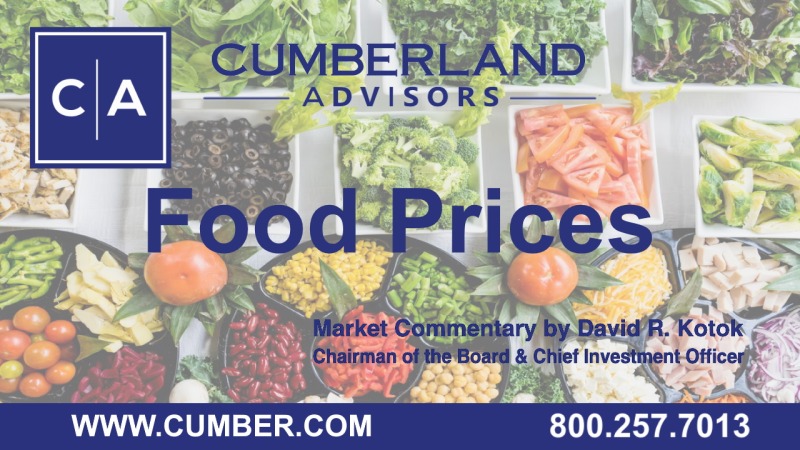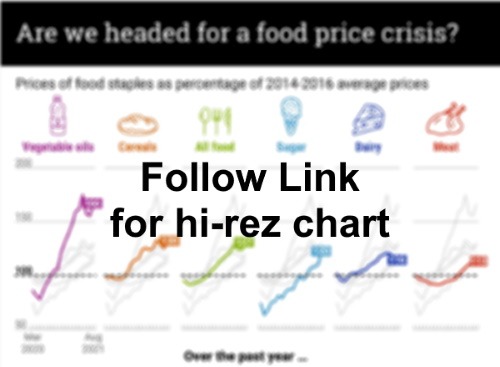We are approaching the unique American Thanksgiving holiday; let’s consider history and then the present day status of food and its price.

We start with history by citing Al-Nuwayri, a historian born in Egypt in 1272, who, at age 16, encountered an epidemic in his country caused by a still unidentified disease. Examining history for the year 1295 he wrote about prices of food (citation source: Lapham’s Quarterly, Vol. XIII, Number 3). This is excerpted from English translation of al-Nuwayri’s thirty-three volume encyclopedia, which was his lifetime project.
“In this year (1295) prices rose, and there was wide spread plague. The price of wheat rose to 167 dirhams per irdabb (about 154 lb.), and it was said that it even reached 180 dirhams. This was followed by a terrible plague, and prices rose for every kind of foodstuff. A single chicken cost twenty dirhams. I heard a story that a man went to buy some chickens to cook for someone who was ill at home. He weighed them and found that they weighed as much as the silver coins that he bought them with! Melons sold for four fine silver dirhams per pound, while a single quince cost thirty. This was the situation in Cairo.“
Here's where we are today.
Citing a compelling chart from from GZERO Media, “The Graphic Truth: Are we headed for a food price crisis?” (https://www.gzeromedia.com/living-beyond-borders-articles/the-graphic-truth-are-we-headed-for-a-food-price-crisis), Ian Bremmer, GZERO president and founder of Eurasia Group, raises a serious question about food shortages and food prices rising because of them.
History shows that hungry people react violently and create political disruption. History also shows that pandemics have created disruptions and regime change. There are no exceptions in history from the biblical times of Pharaoh to Ancient Greece through the Great Plague and to the 17th century Italian city states and to the Spanish flu a century ago and now to the COVID pandemic of 2020–2021–2022 (perhaps longer).
To see where hunger is hitting hardest this year, see GZERO’s chart: “The Graphic Truth: Global hunger hotspots in 2021,” https://www.gzeromedia.com/the-graphic-truth-global-hunger-hotspots-in-2021.
No central bank in the world grows food, operates farm equipment, or harvests a crop. To do those things, you need capital investment in land and equipment, and you need people to do the work. Ag requires people.
In a pandemic scenario many people die. With COVID, for every death there are another 11 (latest estimates are in a range of 6 to 20 with eleven as an approximate mean of estimates) persons who are temporarily, partially, or permanently disabled from Long COVID. These disabilities last for months or for years.
We can draw several inferences.
First, food prices are headed higher worldwide, and there is nothing any central bank can do about it. But if the central bank makes the capital cost too high by raising the real (inflation-adjusted) interest rate too high, too fast, the central bank will create even higher food price levels by exacerbating the food shortages. That may add to political disruption.
Second, the United States is short working people, particularly in immigrant labor for agriculture. COVID hasn’t helped. That shortage will continue and will probably worsen because we don’t let enough new working immigrants into our country. They want to come in, but obstacles imposed by federal rules and many states’ rules stand in the way.
This could change but a change requires leadership. Imagine how massively the US could improve its federal budget balance if the country added 10–15 million younger workers to the labor force. They would fill the unfilled jobs, help produce food, pay taxes, change our national demographic trend in the direction of younger, not older. And they would dramatically alter the “dependency ratio” in our country.
These are the ways to relieve stress on food prices and fiscal pressures on budgets. The answer awaits the political will to put the national interest ahead of political party power. Will it happen? Only when our citizens are hungry enough to demand that Democrats and Republicans put the nation first.
We’re not there yet. But anger and hunger are growing, and each is a powerful force. Maybe, in the COVID period, the forces for change are now getting stronger.
We wish all readers a safe and pleasant Thanksgiving holiday.
David R. Kotok
Chairman and Chief Investment Officer
Email | Bio
Links to other websites or electronic media controlled or offered by Third-Parties (non-affiliates of Cumberland Advisors) are provided only as a reference and courtesy to our users. Cumberland Advisors has no control over such websites, does not recommend or endorse any opinions, ideas, products, information, or content of such sites, and makes no warranties as to the accuracy, completeness, reliability or suitability of their content. Cumberland Advisors hereby disclaims liability for any information, materials, products or services posted or offered at any of the Third-Party websites. The Third-Party may have a privacy and/or security policy different from that of Cumberland Advisors. Therefore, please refer to the specific privacy and security policies of the Third-Party when accessing their websites.
Cumberland Advisors Market Commentaries offer insights and analysis on upcoming, important economic issues that potentially impact global financial markets. Our team shares their thinking on global economic developments, market news and other factors that often influence investment opportunities and strategies.


